Evaluate Triple Integral Y 2 Dv Where E Is the Solid Hemisphere
Multiple Integration
34 Triple Integrals in Cylindrical and Spherical Coordinates
Learning Objectives
- Evaluate a triple integral by changing to cylindrical coordinates.
- Evaluate a triple integral by changing to spherical coordinates.
Earlier in this chapter we showed how to convert a double integral in rectangular coordinates into a double integral in polar coordinates in order to deal more conveniently with problems involving circular symmetry. A similar situation occurs with triple integrals, but here we need to distinguish between cylindrical symmetry and spherical symmetry. In this section we convert triple integrals in rectangular coordinates into a triple integral in either cylindrical or spherical coordinates.
Also recall the chapter opener, which showed the opera house l'Hemisphèric in Valencia, Spain. It has four sections with one of the sections being a theater in a five-story-high sphere (ball) under an oval roof as long as a football field. Inside is an IMAX screen that changes the sphere into a planetarium with a sky full of ![]() twinkling stars. Using triple integrals in spherical coordinates, we can find the volumes of different geometric shapes like these.
twinkling stars. Using triple integrals in spherical coordinates, we can find the volumes of different geometric shapes like these.
Review of Cylindrical Coordinates
As we have seen earlier, in two-dimensional space ![]() a point with rectangular coordinates
a point with rectangular coordinates ![]() can be identified with
can be identified with ![]() in polar coordinates and vice versa, where
in polar coordinates and vice versa, where ![]()
![]()
![]() and
and ![]() are the relationships between the variables.
are the relationships between the variables.
In three-dimensional space ![]() a point with rectangular coordinates
a point with rectangular coordinates ![]() can be identified with cylindrical coordinates
can be identified with cylindrical coordinates ![]() and vice versa. We can use these same conversion relationships, adding
and vice versa. We can use these same conversion relationships, adding ![]() as the vertical distance to the point from the
as the vertical distance to the point from the ![]() -plane as shown in the following figure.
-plane as shown in the following figure.
Cylindrical coordinates are similar to polar coordinates with a vertical ![]() coordinate added.
coordinate added.
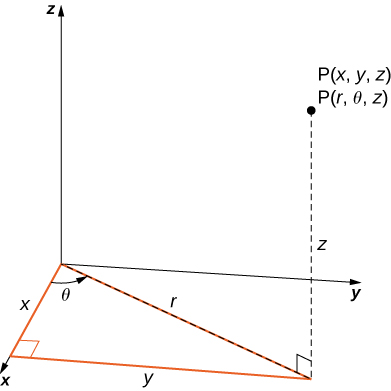
To convert from rectangular to cylindrical coordinates, we use the conversion ![]() and
and ![]() To convert from cylindrical to rectangular coordinates, we use
To convert from cylindrical to rectangular coordinates, we use ![]() and
and ![]() The
The ![]() -coordinate remains the same in both cases.
-coordinate remains the same in both cases.
In the two-dimensional plane with a rectangular coordinate system, when we say ![]() (constant) we mean an unbounded vertical line parallel to the
(constant) we mean an unbounded vertical line parallel to the ![]() -axis and when
-axis and when ![]() (constant) we mean an unbounded horizontal line parallel to the
(constant) we mean an unbounded horizontal line parallel to the ![]() -axis. With the polar coordinate system, when we say
-axis. With the polar coordinate system, when we say ![]() (constant), we mean a circle of radius
(constant), we mean a circle of radius ![]() units and when
units and when ![]() (constant) we mean an infinite ray making an angle
(constant) we mean an infinite ray making an angle ![]() with the positive
with the positive ![]() -axis.
-axis.
Similarly, in three-dimensional space with rectangular coordinates ![]() the equations
the equations ![]() and
and ![]() where
where ![]() and
and ![]() are constants, represent unbounded planes parallel to the
are constants, represent unbounded planes parallel to the ![]() -plane,
-plane, ![]() -plane and
-plane and ![]() -plane, respectively. With cylindrical coordinates
-plane, respectively. With cylindrical coordinates ![]() by
by ![]() and
and ![]() where
where ![]() and
and ![]() are constants, we mean an unbounded vertical cylinder with the
are constants, we mean an unbounded vertical cylinder with the ![]() -axis as its radial axis; a plane making a constant angle
-axis as its radial axis; a plane making a constant angle ![]() with the
with the ![]() -plane; and an unbounded horizontal plane parallel to the
-plane; and an unbounded horizontal plane parallel to the ![]() -plane, respectively. This means that the circular cylinder
-plane, respectively. This means that the circular cylinder ![]() in rectangular coordinates can be represented simply as
in rectangular coordinates can be represented simply as ![]() in cylindrical coordinates. (Refer to Cylindrical and Spherical Coordinates for more review.)
in cylindrical coordinates. (Refer to Cylindrical and Spherical Coordinates for more review.)
Integration in Cylindrical Coordinates
Triple integrals can often be more readily evaluated by using cylindrical coordinates instead of rectangular coordinates. Some common equations of surfaces in rectangular coordinates along with corresponding equations in cylindrical coordinates are listed in (Figure). These equations will become handy as we proceed with solving problems using triple integrals.
| Circular cylinder | Circular cone | Sphere | Paraboloid | |
|---|---|---|---|---|
| Rectangular | | | | |
| Cylindrical | | | | |
As before, we start with the simplest bounded region ![]() in
in ![]() to describe in cylindrical coordinates, in the form of a cylindrical box,
to describe in cylindrical coordinates, in the form of a cylindrical box, ![]() ((Figure)). Suppose we divide each interval into
((Figure)). Suppose we divide each interval into ![]() subdivisions such that
subdivisions such that ![]() and
and ![]() Then we can state the following definition for a triple integral in cylindrical coordinates.
Then we can state the following definition for a triple integral in cylindrical coordinates.
A cylindrical box ![]() described by cylindrical coordinates.
described by cylindrical coordinates.
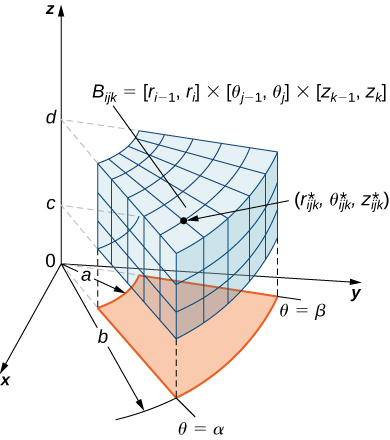
Definition
Consider the cylindrical box (expressed in cylindrical coordinates)
![]()
If the function ![]() is continuous on
is continuous on ![]() and if
and if ![]() is any sample point in the cylindrical subbox
is any sample point in the cylindrical subbox ![]() ((Figure)), then we can define the triple integral in cylindrical coordinates as the limit of a triple Riemann sum, provided the following limit exists:
((Figure)), then we can define the triple integral in cylindrical coordinates as the limit of a triple Riemann sum, provided the following limit exists:
![]()
Note that if ![]() is the function in rectangular coordinates and the box
is the function in rectangular coordinates and the box ![]() is expressed in rectangular coordinates, then the triple integral
is expressed in rectangular coordinates, then the triple integral ![]() is equal to the triple integral
is equal to the triple integral ![]() and we have
and we have

As mentioned in the preceding section, all the properties of a double integral work well in triple integrals, whether in rectangular coordinates or cylindrical coordinates. They also hold for iterated integrals. To reiterate, in cylindrical coordinates, Fubini's theorem takes the following form:
Fubini's Theorem in Cylindrical Coordinates
Suppose that ![]() is continuous on a rectangular box
is continuous on a rectangular box ![]() which when described in cylindrical coordinates looks like
which when described in cylindrical coordinates looks like ![]()
Then ![]() and
and
![]()
The iterated integral may be replaced equivalently by any one of the other five iterated integrals obtained by integrating with respect to the three variables in other orders.
Cylindrical coordinate systems work well for solids that are symmetric around an axis, such as cylinders and cones. Let us look at some examples before we define the triple integral in cylindrical coordinates on general cylindrical regions.
Evaluating a Triple Integral over a Cylindrical Box
Evaluate the triple integral ![]() where the cylindrical box
where the cylindrical box ![]() is
is ![]()
As stated in Fubini's theorem, we can write the triple integral as the iterated integral
![]()
The evaluation of the iterated integral is straightforward. Each variable in the integral is independent of the others, so we can integrate each variable separately and multiply the results together. This makes the computation much easier:
![]()
Evaluate the triple integral ![]()
![]()
Hint
Follow the same steps as in the previous example.
If the cylindrical region over which we have to integrate is a general solid, we look at the projections onto the coordinate planes. Hence the triple integral of a continuous function ![]() over a general solid region
over a general solid region ![]() in
in ![]() where
where ![]() is the projection of
is the projection of ![]() onto the
onto the ![]() -plane, is
-plane, is
![Rendered by QuickLaTeX.com \underset{E}{\iiint }f\left(r,\theta ,z\right)r\phantom{\rule{0.2em}{0ex}}dr\phantom{\rule{0.2em}{0ex}}d\theta \phantom{\rule{0.2em}{0ex}}dz=\underset{D}{\iint }\left[\underset{{u}_{1}\left(r,\theta \right)}{\overset{{u}_{2}\left(r,\theta \right)}{\int }}f\left(r,\theta ,z\right)dz\right]r\phantom{\rule{0.2em}{0ex}}dr\phantom{\rule{0.2em}{0ex}}d\theta .](https://opentextbc.ca/calculusv3openstax/wp-content/ql-cache/quicklatex.com-abfaa1120099561116e97d91978b8b1e_l3.png)
In particular, if ![]() then we have
then we have

Similar formulas exist for projections onto the other coordinate planes. We can use polar coordinates in those planes if necessary.
Setting up a Triple Integral in Cylindrical Coordinates over a General Region
Consider the region ![]() inside the right circular cylinder with equation
inside the right circular cylinder with equation ![]() bounded below by the
bounded below by the ![]() -plane and bounded above by the sphere with radius
-plane and bounded above by the sphere with radius ![]() centered at the origin ((Figure)). Set up a triple integral over this region with a function
centered at the origin ((Figure)). Set up a triple integral over this region with a function ![]() in cylindrical coordinates.
in cylindrical coordinates.
Setting up a triple integral in cylindrical coordinates over a cylindrical region.
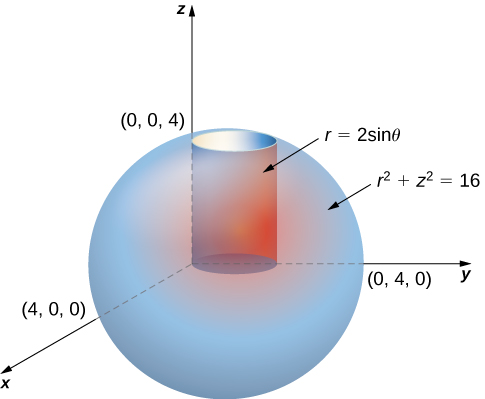
Consider the region ![]() inside the right circular cylinder with equation
inside the right circular cylinder with equation ![]() bounded below by the
bounded below by the ![]() -plane and bounded above by
-plane and bounded above by ![]() Set up a triple integral with a function
Set up a triple integral with a function ![]() in cylindrical coordinates.
in cylindrical coordinates.
![]()
Hint
Analyze the region, and draw a sketch.
Setting up a Triple Integral in Two Ways
Let ![]() be the region bounded below by the cone
be the region bounded below by the cone ![]() and above by the paraboloid
and above by the paraboloid ![]() ((Figure)). Set up a triple integral in cylindrical coordinates to find the volume of the region, using the following orders of integration:
((Figure)). Set up a triple integral in cylindrical coordinates to find the volume of the region, using the following orders of integration:
-

-

Setting up a triple integral in cylindrical coordinates over a conical region.
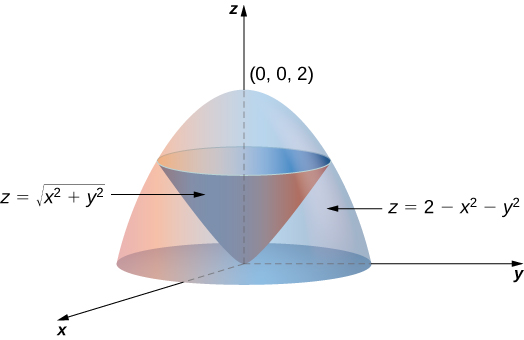
Redo the previous example with the order of integration ![]()
![]() and
and ![]()
Hint
Note that ![]() is independent of
is independent of ![]() and
and ![]()
Finding a Volume with Triple Integrals in Two Ways
Let E be the region bounded below by the ![]() -plane, above by the sphere
-plane, above by the sphere ![]() and on the sides by the cylinder
and on the sides by the cylinder ![]() ((Figure)). Set up a triple integral in cylindrical coordinates to find the volume of the region using the following orders of integration, and in each case find the volume and check that the answers are the same:
((Figure)). Set up a triple integral in cylindrical coordinates to find the volume of the region using the following orders of integration, and in each case find the volume and check that the answers are the same:
-

-

Finding a cylindrical volume with a triple integral in cylindrical coordinates.
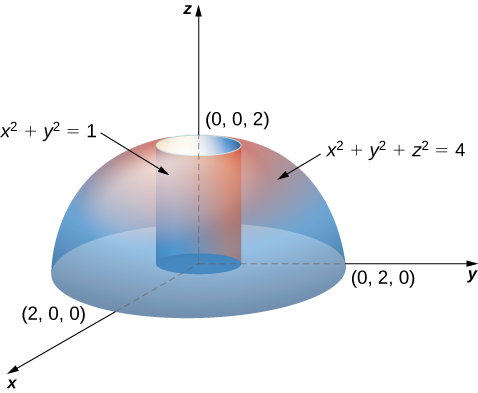
- Note that the equation for the sphere is

and the equation for the cylinder is

Thus, we have for the region

Hence the integral for the volume is
![Rendered by QuickLaTeX.com \begin{array}{cc}\hfill V\left(E\right)& =\underset{\theta =0}{\overset{\theta =2\pi }{\int }}\phantom{\rule{0.2em}{0ex}}\underset{r=0}{\overset{r=1}{\int }}\phantom{\rule{0.2em}{0ex}}\underset{z=0}{\overset{z=\sqrt{4-{r}^{2}}}{\int }}r\phantom{\rule{0.2em}{0ex}}dz\phantom{\rule{0.2em}{0ex}}dr\phantom{\rule{0.2em}{0ex}}d\theta \hfill \\ & =\underset{\theta =0}{\overset{\theta =2\pi }{\int }}\phantom{\rule{0.2em}{0ex}}\underset{r=0}{\overset{r=1}{\int }}\left[{rz|}_{z=0}^{z=\sqrt{4-{r}^{2}}}\right]dr\phantom{\rule{0.2em}{0ex}}d\theta =\underset{\theta =0}{\overset{\theta =2\pi }{\int }}\phantom{\rule{0.2em}{0ex}}\underset{r=0}{\overset{r=1}{\int }}\left(r\sqrt{4-{r}^{2}}\right)dr\phantom{\rule{0.2em}{0ex}}d\theta \hfill \\ & =\underset{0}{\overset{2\pi }{\int }}\left(\frac{8}{3}-\sqrt{3}\right)d\theta =2\pi \left(\frac{8}{3}-\sqrt{3}\right)\phantom{\rule{0.2em}{0ex}}\text{cubic units}\text{.}\hfill \end{array}](https://opentextbc.ca/calculusv3openstax/wp-content/ql-cache/quicklatex.com-3ef3cf7d1e98237b4d38a5ee019abc7f_l3.png)
- Since the sphere is
 which is
which is  and the cylinder is
and the cylinder is  which is
which is  we have
we have  that is,
that is,  Thus we have two regions, since the sphere and the cylinder intersect at
Thus we have two regions, since the sphere and the cylinder intersect at  in the
in the  -plane
-plane

and

Hence the integral for the volume is

Redo the previous example with the order of integration ![]()
![]() and
and ![]()
Hint
A figure can be helpful. Note that ![]() is independent of
is independent of ![]() and
and ![]()
Review of Spherical Coordinates
In three-dimensional space ![]() in the spherical coordinate system, we specify a point
in the spherical coordinate system, we specify a point ![]() by its distance
by its distance ![]() from the origin, the polar angle
from the origin, the polar angle ![]() from the positive
from the positive ![]() (same as in the cylindrical coordinate system), and the angle
(same as in the cylindrical coordinate system), and the angle ![]() from the positive
from the positive ![]() and the line
and the line ![]() ((Figure)). Note that
((Figure)). Note that ![]() and
and ![]() (Refer to Cylindrical and Spherical Coordinates for a review.) Spherical coordinates are useful for triple integrals over regions that are symmetric with respect to the origin.
(Refer to Cylindrical and Spherical Coordinates for a review.) Spherical coordinates are useful for triple integrals over regions that are symmetric with respect to the origin.
The spherical coordinate system locates points with two angles and a distance from the origin.
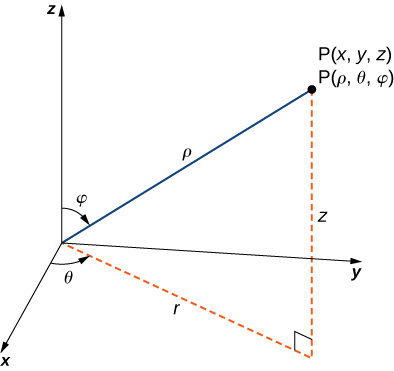
Recall the relationships that connect rectangular coordinates with spherical coordinates.
From spherical coordinates to rectangular coordinates:
![]()
From rectangular coordinates to spherical coordinates:
![]()
Other relationships that are important to know for conversions are

and
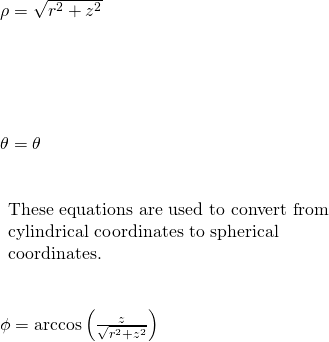
The following figure shows a few solid regions that are convenient to express in spherical coordinates.
Spherical coordinates are especially convenient for working with solids bounded by these types of surfaces. (The letter ![]() indicates a constant.)
indicates a constant.)

Integration in Spherical Coordinates
We now establish a triple integral in the spherical coordinate system, as we did before in the cylindrical coordinate system. Let the function ![]() be continuous in a bounded spherical box,
be continuous in a bounded spherical box, ![]() We then divide each interval into
We then divide each interval into ![]() subdivisions such that
subdivisions such that ![]()
Now we can illustrate the following theorem for triple integrals in spherical coordinates with ![]() being any sample point in the spherical subbox
being any sample point in the spherical subbox ![]() For the volume element of the subbox
For the volume element of the subbox ![]() in spherical coordinates, we have
in spherical coordinates, we have ![]() as shown in the following figure.
as shown in the following figure.
The volume element of a box in spherical coordinates.
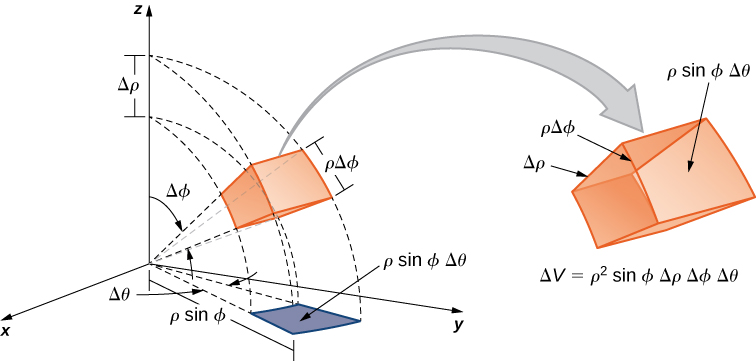
Definition
The triple integral in spherical coordinates is the limit of a triple Riemann sum,
![]()
provided the limit exists.
As with the other multiple integrals we have examined, all the properties work similarly for a triple integral in the spherical coordinate system, and so do the iterated integrals. Fubini's theorem takes the following form.
Fubini's Theorem for Spherical Coordinates
If ![]() is continuous on a spherical solid box
is continuous on a spherical solid box ![]() then
then
![]()
This iterated integral may be replaced by other iterated integrals by integrating with respect to the three variables in other orders.
As stated before, spherical coordinate systems work well for solids that are symmetric around a point, such as spheres and cones. Let us look at some examples before we consider triple integrals in spherical coordinates on general spherical regions.
Evaluating a Triple Integral in Spherical Coordinates
Evaluate the iterated triple integral 
As before, in this case the variables in the iterated integral are actually independent of each other and hence we can integrate each piece and multiply:
![]()
The concept of triple integration in spherical coordinates can be extended to integration over a general solid, using the projections onto the coordinate planes. Note that ![]() and
and ![]() mean the increments in volume and area, respectively. The variables
mean the increments in volume and area, respectively. The variables ![]() and
and ![]() are used as the variables for integration to express the integrals.
are used as the variables for integration to express the integrals.
The triple integral of a continuous function ![]() over a general solid region
over a general solid region
![]()
in ![]() where
where ![]() is the projection of
is the projection of ![]() onto the
onto the ![]() -plane, is
-plane, is
![Rendered by QuickLaTeX.com \underset{E}{\iiint }f\left(\rho ,\theta ,\phi \right)dV=\underset{D}{\iint }\left[\underset{{u}_{1}\left(\rho ,\theta \right)}{\overset{{u}_{2}\left(\rho ,\theta \right)}{\int }}f\left(\rho ,\theta ,\phi \right)d\phi \right]dA.](https://opentextbc.ca/calculusv3openstax/wp-content/ql-cache/quicklatex.com-17ed6686b62774cb11556e7d53912925_l3.png)
In particular, if ![]() then we have
then we have

Similar formulas occur for projections onto the other coordinate planes.
Setting up a Triple Integral in Spherical Coordinates
Set up an integral for the volume of the region bounded by the cone ![]() and the hemisphere
and the hemisphere ![]() (see the figure below).
(see the figure below).
A region bounded below by a cone and above by a hemisphere.
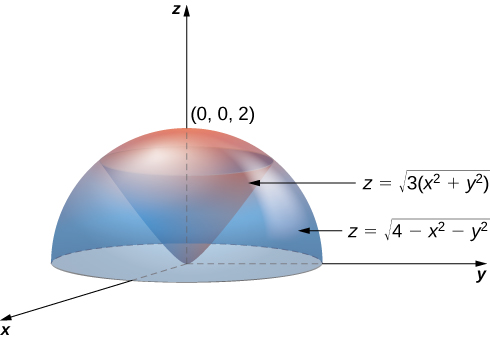
Set up a triple integral for the volume of the solid region bounded above by the sphere ![]() and bounded below by the cone
and bounded below by the cone ![]()

Hint
Follow the steps of the previous example.
Interchanging Order of Integration in Spherical Coordinates
Let ![]() be the region bounded below by the cone
be the region bounded below by the cone ![]() and above by the sphere
and above by the sphere ![]() ((Figure)). Set up a triple integral in spherical coordinates and find the volume of the region using the following orders of integration:
((Figure)). Set up a triple integral in spherical coordinates and find the volume of the region using the following orders of integration:
-

-

A region bounded below by a cone and above by a sphere.

- Use the conversion formulas to write the equations of the sphere and cone in spherical coordinates.
For the sphere:

For the cone:
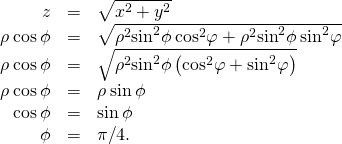
Hence the integral for the volume of the solid region becomes
becomes

- Consider the
 -plane. Note that the ranges for
-plane. Note that the ranges for  and
and  (from part a.) are
(from part a.) are

The curve meets the line
meets the line  at the point
at the point  Thus, to change the order of integration, we need to use two pieces:
Thus, to change the order of integration, we need to use two pieces:

Hence the integral for the volume of the solid region becomes
becomes

In each case, the integration results in
Before we end this section, we present a couple of examples that can illustrate the conversion from rectangular coordinates to cylindrical coordinates and from rectangular coordinates to spherical coordinates.
Converting from Rectangular Coordinates to Cylindrical Coordinates
Convert the following integral into cylindrical coordinates:

The ranges of the variables are

The first two inequalities describe the right half of a circle of radius ![]() Therefore, the ranges for
Therefore, the ranges for ![]() and
and ![]() are
are
![]()
The limits of ![]() are
are ![]() hence
hence

Converting from Rectangular Coordinates to Spherical Coordinates
Convert the following integral into spherical coordinates:

The ranges of the variables are

The first two ranges of variables describe a quarter disk in the first quadrant of the ![]() -plane. Hence the range for
-plane. Hence the range for ![]() is
is ![]()
The lower bound ![]() is the upper half of a cone and the upper bound
is the upper half of a cone and the upper bound ![]() is the upper half of a sphere. Therefore, we have
is the upper half of a sphere. Therefore, we have ![]() which is
which is ![]()
For the ranges of ![]() we need to find where the cone and the sphere intersect, so solve the equation
we need to find where the cone and the sphere intersect, so solve the equation
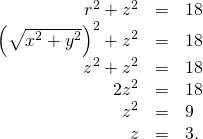
This gives

Putting this together, we obtain

Use rectangular, cylindrical, and spherical coordinates to set up triple integrals for finding the volume of the region inside the sphere ![]() but outside the cylinder
but outside the cylinder ![]()
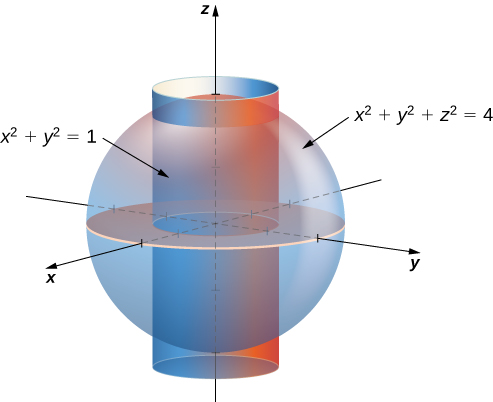
Rectangular: 
Cylindrical: 
Spherical: 
Now that we are familiar with the spherical coordinate system, let's find the volume of some known geometric figures, such as spheres and ellipsoids.
Chapter Opener: Finding the Volume of l'Hemisphèric
Find the volume of the spherical planetarium in l'Hemisphèric in Valencia, Spain, which is five stories tall and has a radius of approximately ![]() ft, using the equation
ft, using the equation ![]()
(credit: modification of work by Javier Yaya Tur, Wikimedia Commons)

We calculate the volume of the ball in the first octant, where ![]() and
and ![]() using spherical coordinates, and then multiply the result by
using spherical coordinates, and then multiply the result by ![]() for symmetry. Since we consider the region
for symmetry. Since we consider the region ![]() as the first octant in the integral, the ranges of the variables are
as the first octant in the integral, the ranges of the variables are
![]()
Therefore,
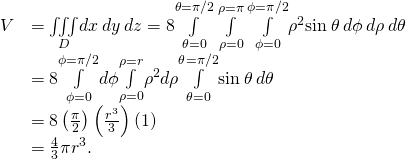
This exactly matches with what we knew. So for a sphere with a radius of approximately ![]() ft, the volume is
ft, the volume is ![]()
For the next example we find the volume of an ellipsoid.
Finding the Volume of an Ellipsoid
Find the volume of the ellipsoid ![]()
We again use symmetry and evaluate the volume of the ellipsoid using spherical coordinates. As before, we use the first octant ![]() and
and ![]() and then multiply the result by
and then multiply the result by ![]()
In this case the ranges of the variables are
![]()
Also, we need to change the rectangular to spherical coordinates in this way:
![]()
Then the volume of the ellipsoid becomes
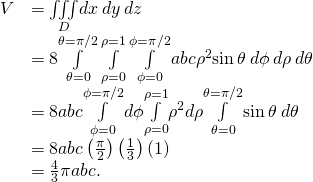
Finding the Volume of the Space Inside an Ellipsoid and Outside a Sphere
Find the volume of the space inside the ellipsoid ![]() and outside the sphere
and outside the sphere ![]()
This problem is directly related to the l'Hemisphèric structure. The volume of space inside the ellipsoid and outside the sphere might be useful to find the expense of heating or cooling that space. We can use the preceding two examples for the volume of the sphere and ellipsoid and then substract.
First we find the volume of the ellipsoid using ![]()
![]() and
and ![]() in the result from (Figure). Hence the volume of the ellipsoid is
in the result from (Figure). Hence the volume of the ellipsoid is
![]()
From (Figure), the volume of the sphere is
![]()
Therefore, the volume of the space inside the ellipsoid ![]() and outside the sphere
and outside the sphere ![]() is approximately
is approximately
![]()
Hot air balloons
Hot air ballooning is a relaxing, peaceful pastime that many people enjoy. Many balloonist gatherings take place around the world, such as the Albuquerque International Balloon Fiesta. The Albuquerque event is the largest hot air balloon festival in the world, with over ![]() balloons participating each year.
balloons participating each year.
Balloons lift off at the ![]() Albuquerque International Balloon Fiesta. (credit: David Herrera, Flickr)
Albuquerque International Balloon Fiesta. (credit: David Herrera, Flickr)

As the name implies, hot air balloons use hot air to generate lift. (Hot air is less dense than cooler air, so the balloon floats as long as the hot air stays hot.) The heat is generated by a propane burner suspended below the opening of the basket. Once the balloon takes off, the pilot controls the altitude of the balloon, either by using the burner to heat the air and ascend or by using a vent near the top of the balloon to release heated air and descend. The pilot has very little control over where the balloon goes, however—balloons are at the mercy of the winds. The uncertainty over where we will end up is one of the reasons balloonists are attracted to the sport.
In this project we use triple integrals to learn more about hot air balloons. We model the balloon in two pieces. The top of the balloon is modeled by a half sphere of radius ![]() feet. The bottom of the balloon is modeled by a frustum of a cone (think of an ice cream cone with the pointy end cut off). The radius of the large end of the frustum is
feet. The bottom of the balloon is modeled by a frustum of a cone (think of an ice cream cone with the pointy end cut off). The radius of the large end of the frustum is ![]() feet and the radius of the small end of the frustum is
feet and the radius of the small end of the frustum is ![]() feet. A graph of our balloon model and a cross-sectional diagram showing the dimensions are shown in the following figure.
feet. A graph of our balloon model and a cross-sectional diagram showing the dimensions are shown in the following figure.
(a) Use a half sphere to model the top part of the balloon and a frustum of a cone to model the bottom part of the balloon. (b) A cross section of the balloon showing its dimensions.
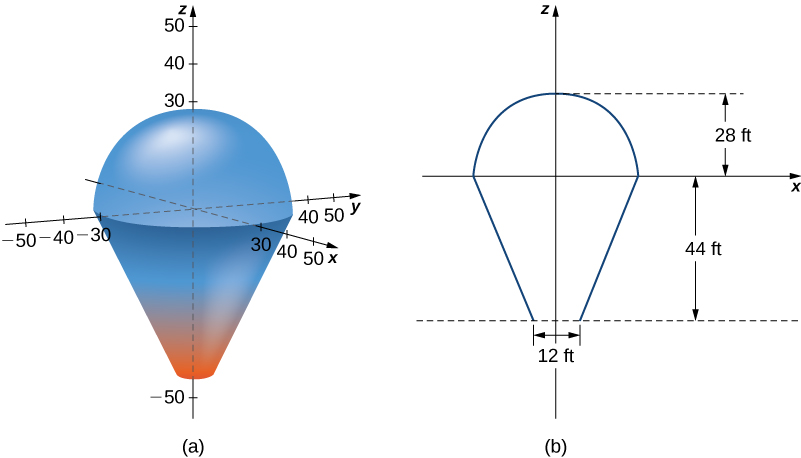
We first want to find the volume of the balloon. If we look at the top part and the bottom part of the balloon separately, we see that they are geometric solids with known volume formulas. However, it is still worthwhile to set up and evaluate the integrals we would need to find the volume. If we calculate the volume using integration, we can use the known volume formulas to check our answers. This will help ensure that we have the integrals set up correctly for the later, more complicated stages of the project.
- Find the volume of the balloon in two ways.
- Use triple integrals to calculate the volume. Consider each part of the balloon separately. (Consider using spherical coordinates for the top part and cylindrical coordinates for the bottom part.)
- Verify the answer using the formulas for the volume of a sphere,
 and for the volume of a cone,
and for the volume of a cone, 
In reality, calculating the temperature at a point inside the balloon is a tremendously complicated endeavor. In fact, an entire branch of physics (thermodynamics) is devoted to studying heat and temperature. For the purposes of this project, however, we are going to make some simplifying assumptions about how temperature varies from point to point within the balloon. Assume that just prior to liftoff, the temperature (in degrees Fahrenheit) of the air inside the balloon varies according to the function

- What is the average temperature of the air in the balloon just prior to liftoff? (Again, look at each part of the balloon separately, and do not forget to convert the function into spherical coordinates when looking at the top part of the balloon.)
Now the pilot activates the burner for seconds. This action affects the temperature in a
seconds. This action affects the temperature in a  -foot-wide column
-foot-wide column  feet high, directly above the burner. A cross section of the balloon depicting this column in shown in the following figure.
feet high, directly above the burner. A cross section of the balloon depicting this column in shown in the following figure.
Activating the burner heats the air in a
 -foot-high,
-foot-high,  -foot-wide column directly above the burner.
-foot-wide column directly above the burner.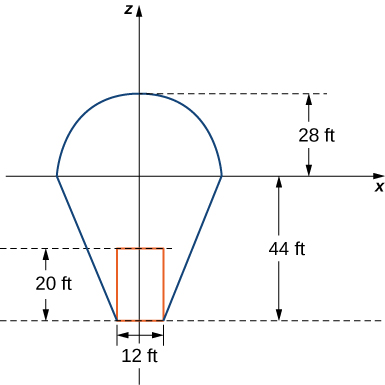
Assume that after the pilot activates the burner for seconds, the temperature of the air in the column described above increases according to the formula
seconds, the temperature of the air in the column described above increases according to the formula

Then the temperature of the air in the column is given by

while the temperature in the remainder of the balloon is still given by

- Find the average temperature of the air in the balloon after the pilot has activated the burner for
 seconds.
seconds.
Key Concepts
- To evaluate a triple integral in cylindrical coordinates, use the iterated integral

- To evaluate a triple integral in spherical coordinates, use the iterated integral

Key Equations
In the following exercises, evaluate the triple integrals ![]() over the solid
over the solid ![]()
![]()
![]()
![]()
![]()
![]()
![]()
![]()
![]()
In the following exercises, the boundaries of the solid ![]() are given in cylindrical coordinates.
are given in cylindrical coordinates.
- Express the region
 in cylindrical coordinates.
in cylindrical coordinates. - Convert the integral
 to cylindrical coordinates.
to cylindrical coordinates.
In the following exercises, the function ![]() and region
and region ![]() are given.
are given.
- Express the region
 and the function
and the function  in cylindrical coordinates.
in cylindrical coordinates. - Convert the integral
 into cylindrical coordinates and evaluate it.
into cylindrical coordinates and evaluate it.
![]()
![]()
![]()
![]()
In the following exercises, find the volume of the solid ![]() whose boundaries are given in rectangular coordinates.
whose boundaries are given in rectangular coordinates.
![]() is bounded by the circular cone
is bounded by the circular cone ![]() and
and ![]()
![]()
[T] Use a computer algebra system (CAS) to graph the solid whose volume is given by the iterated integral in cylindrical coordinates  Find the volume
Find the volume ![]() of the solid. Round your answer to four decimal places.
of the solid. Round your answer to four decimal places.
![]()
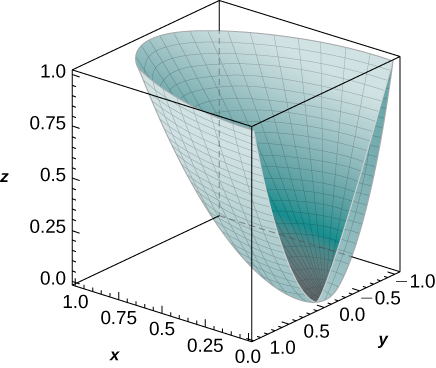
[T] Use a CAS to graph the solid whose volume is given by the iterated integral in cylindrical coordinates ![]() Find the volume
Find the volume ![]() of the solid Round your answer to four decimal places.
of the solid Round your answer to four decimal places.
Convert the integral  into an integral in cylindrical coordinates.
into an integral in cylindrical coordinates.
![]()
Convert the integral ![]() into an integral in cylindrical coordinates.
into an integral in cylindrical coordinates.
In the following exercises, evaluate the triple integral ![]() over the solid
over the solid ![]()
![]()
Show that if ![]() is a continuous function on the spherical box
is a continuous function on the spherical box ![]() then
then

In the following exercises, the function ![]() and region
and region ![]() are given.
are given.
- Express the region
 and function
and function  in cylindrical coordinates.
in cylindrical coordinates. - Convert the integral
 into cylindrical coordinates and evaluate it.
into cylindrical coordinates and evaluate it.
![]()
![]()
![]()
![]()
In the following exercises, find the volume of the solid ![]() whose boundaries are given in rectangular coordinates.
whose boundaries are given in rectangular coordinates.
![]()
![]()
![]()
Use spherical coordinates to find the volume of the ball ![]() that is situated between the cones
that is situated between the cones ![]()
![]()
Convert the integral  into an integral in spherical coordinates.
into an integral in spherical coordinates.
Convert the integral  into an integral in spherical coordinates.
into an integral in spherical coordinates.
![]()
Convert the integral  into an integral in spherical coordinates and evaluate it.
into an integral in spherical coordinates and evaluate it.
[T] Use a CAS to graph the solid whose volume is given by the iterated integral in spherical coordinates  Find the volume
Find the volume ![]() of the solid. Round your answer to three decimal places.
of the solid. Round your answer to three decimal places.
![]()
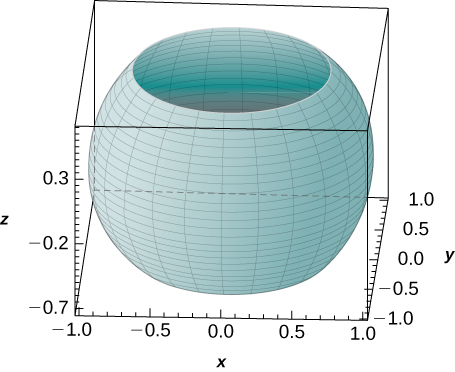
[T] Use a CAS to graph the solid whose volume is given by the iterated integral in spherical coordinates as  Find the volume
Find the volume ![]() of the solid. Round your answer to three decimal places.
of the solid. Round your answer to three decimal places.
Express the volume of the solid inside the sphere ![]() and outside the cylinder
and outside the cylinder ![]() as triple integrals in cylindrical coordinates and spherical coordinates, respectively.
as triple integrals in cylindrical coordinates and spherical coordinates, respectively.


Express the volume of the solid inside the sphere ![]() and outside the cylinder
and outside the cylinder ![]() that is located in the first octant as triple integrals in cylindrical coordinates and spherical coordinates, respectively.
that is located in the first octant as triple integrals in cylindrical coordinates and spherical coordinates, respectively.
![]() watts
watts
Use the preceding exercise to find the total power within a sphere ![]() of radius 5 meters when the power density per unit volume is given by
of radius 5 meters when the power density per unit volume is given by ![]()
Use the preceding exercise to find the total charge cloud contained in the unit sphere if the charge density is ![]()
Glossary
- triple integral in cylindrical coordinates
- the limit of a triple Riemann sum, provided the following limit exists:

- triple integral in spherical coordinates
- the limit of a triple Riemann sum, provided the following limit exists:

Evaluate Triple Integral Y 2 Dv Where E Is the Solid Hemisphere
Source: https://opentextbc.ca/calculusv3openstax/chapter/triple-integrals-in-cylindrical-and-spherical-coordinates/